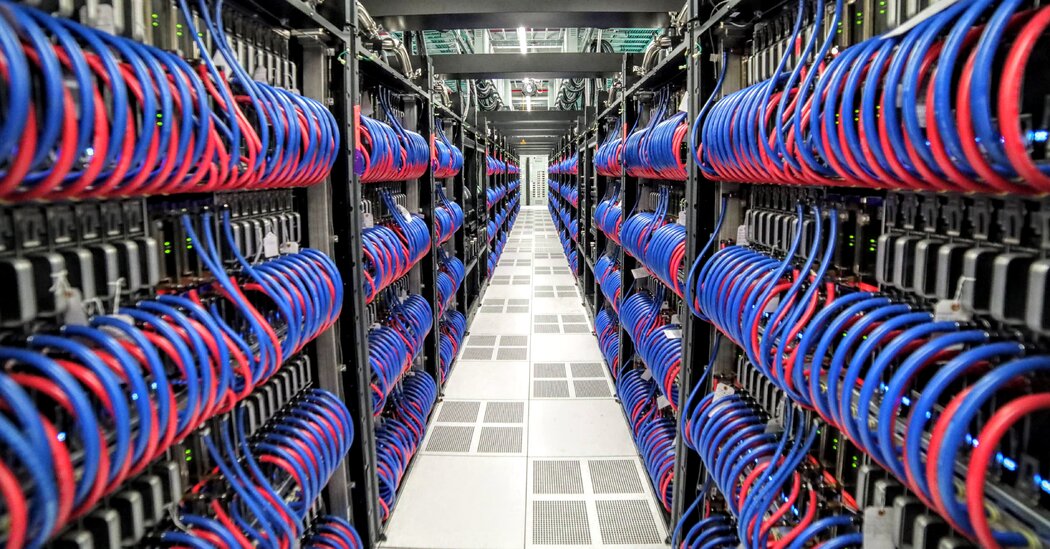The United States has reclaimed a coveted speed crown in computer science with a powerful new supercomputer in Tennessee, a milestone for the technology that plays an important role in science, medicine and other fields.
Frontier, the name of the massive machine at Oak Ridge National Laboratory, was named on Monday as the first to demonstrate the performance of a trillion operations per second — a billion billion calculations — in a series of standard tests used by researchers to rank supercomputers. . The US Department of Energy pledged $1.8 billion a few years ago to build three systems with that “exascale” performance, as scientists call it.
But the crown has a caveat. Some experts believe that Frontier has been defeated by two systems in China in the exascale race. Operators of those systems have not submitted test results for evaluation by scientists who oversee the so-called Top500 ranking. Experts said they suspected tensions between the United States and China may be the reason the Chinese have not submitted the test results.
“There are rumors that China has something,” said Jack Dongarra, a distinguished professor of computer science at the University of Tennessee who leads the Top500 effort. “There’s nothing official.”
Supercomputers have long been a flashpoint in international competition. The room-sized machines were first built for code-cracking and weapon design, but now also play an important role in developing vaccines, testing car designs and modeling climate change.
The field has been dominated by US technology for decades, but China has become a dominant force. A system there called Sunway TaihuLight was the fastest in the world from 2016 to 2018. China accounted for 173 systems on the latest Top500 list, compared to 126 machines in the United States.
Japan was a smaller but still strong competitor. A system called Fugaku, in Kobe, took the #1 spot in June 2020, replacing an IBM system in Oak Ridge.
Frontier returns that top spot to the lab. The system, built by Hewlett Packard Enterprise using two types of chips from Advanced Micro Devices, was more than twice as fast as Fugaku in the tests used by the Top500 organization.
“It’s a proud moment for our nation,” said Thomas Zacharia, executive director of Oak Ridge, during an online briefing from an industry event in Germany. “It reminds us that we can still go after something bigger than us.”
Building the system, consisting of 74 cabinets weighing 8,000 pounds each, was complicated by the pandemic and difficulties in sourcing components in the supply chain crisis, Mr Zacharia said. But he predicted that Frontier would soon have a major impact in studying the impact of Covid and, for example, in the transition to cleaner energy sources.
In the past, Chinese researchers took part in the ranking process. But the country has gotten a lower profile in promoting its advances in supercomputing as the United States has taken a series of steps to slow down China’s technological progress, including making it more difficult for some Chinese companies to acquire the foreign chips that can be used to make supercomputers.
But China has made significant strides in designing its own microprocessors, a key to advancements in supercomputers. David Kahaner, an authority on the field who heads the Asian Technology Information Program, last year reported details on two exascale-class supercomputers that he believes use Chinese chip technology.
One is a successor to the earlier Sunway machine called OceanLight, according to a presentation Mr. Kahaner shared at a technical conference. The other machine, Tianhe-3, is the successor to a system called Tianhe-1A which in 2010 became the first Chinese machine to occupy a No. 1 position in the Top500 list.
More evidence that China broke the exascale barrier emerged in November, when a group of 14 Chinese researchers won a prestigious award from the Association for Computing Machinery, the Gordon Bell Prize, for simulating a quantum computing circuit on the new Sunway system running at exascale speeds. The computation, estimated to take 10,000 years on Oak Ridge’s fastest supercomputer, took 304 seconds on the Chinese system, the researchers reported in a technical paper.
“They leaked that they had machines running at exascale levels,” said Steve Conway, an analyst with Hyperion Research. “A lot of the speculation is that they didn’t want to put in more US sanctions.”
mr. Conway and other experts said they believed the chips in the new Chinese machines were manufactured in Taiwan, which is true for the main chips in Frontier. China is lagging far behind in advanced chip-making capabilities, he said.
The Oak Ridge machine can not only help scientists, but also help suppliers popularize new products. Hewlett Packard Enterprise, which bought supercomputer pioneer Cray in 2019, contributed the network technology SlingShot that had a significant impact on Frontier’s performance, said Mr. Zacharia.
And AMD contributed not only microprocessors, but also a kind of graphics processing chip sold mainly by a rival, Nvidia, for supercomputers. The same two AMD chips were selected for an exascale system called El Capitan that is expected to be installed in 2023 at Lawrence Livermore National Laboratory in California.
A third exascale machine at Argonne National Laboratory in Illinois, featuring three types of chips from Intel, was originally scheduled for delivery in 2021. But manufacturing issues at Intel delayed that system, which is now expected later this year.

